The analytical tools – mapping mobile learning theory to aspects of task design
The underpinning concept of this chapter is that an understanding of how some relevant learning theories are, or could be, used in a mobile learning activity can help us to make the most of mobile learning opportunities, either by selecting a suitable existing activity or by designing a new one. We have addressed the need to be able to assess the relationship between theory and design by creating some evaluation tools, based on some key features of behaviourism (Ertmer & Newby, 2013; Ally, 2004), constructivism (Ally, 2004), experiential learning (Conole, Dyke, Oliver & Seale 2004; Kolb & Kolb, 2009; Beard & Wilson, 2013) situated cognition (Brown, Collins & Duguid, 1989; Herrington & Oliver, 1995), communities of practice (Wenger, 2000; Lai, Pratt, Anderson & Stigter, 2006) and connectivism (Siemens, 2004; Armatas, Spratt & Vincent, 2013; Kizito, 2016).
The tools provided are a set of rubrics and an interactive analyser tool. Although we have suggested in this e-chapter that the rubric may be best suited to assessing an existing activity while the analyser might be more appropriate for designing a new activity, in fact either tool could be used for either purpose.
This section will first discuss the rubric and two examples of how they can be used to evaluate a learning activity, and then discuss the analyser tool alongside an example of how it can be used to develop and improve a learning activity.
The Rubrics
The mobile learning activity rubrics each have 6 levels, where level zero indicates a complete absence of any evidence of this learning theory in a given activity, while level 5 indicates that the activity fully operationalises that particular learning theory. Levels 4 and 5 both indicate a design intent, whereas levels 1, 2 and 3 suggest that certain components of learning theories may be present but may not be an integral part of the learning design. Each rubric has synthesised and assimilated the major aspects of each identified criteria to embody the key aspects of each theory into a form that gives evaluative structure to observations (Brookhart, 2013).
See the Digital Extras section for a short video that provides an overview of how the rubrics work and can be used to evaluate a mobile learning activity.
Example 1: Augmenting the real world with mobile technology
The Ambient Wood Project was an innovative educational project involving primary school children using mobile technology to augment and explore a physical woodland environment (Dix, Finlay, Abowd & Beale, 2003). The following provides a discussion of how the six learning theories have been operationalised in this activity as well as the relative level to which these theories have been embedded within the design (this is the subjective evaluation of the authors and could be the subject of further valuable discussion). The theories are addressed in descending order of the extent to which they have been adopted within this activity.
Experiential Learning
The project centered around pairs of children equipped with a number of devices exploring and reflecting upon a physical environment that had been prepared with a WiFi network and Radio Frequency (RF) location beacons. Exploring this environment was the foundation of the learning and this interaction was basis of the learning experience. This exploratory investigation allowed the children to build complex understandings of the rich ecological environment and lifecycles including the fragility of these habitats. The project was underpinned by experiential learning principles where the children were transforming their experience into knowledge. The children were allowed to explore and discover aspects about plants and animals living in the various habitats in the wood. The field trip was used to encourage learners to discover, reflect, hypothesize and experiment with biological processes taking place within a physical environment (Rogers, et. al., 2002). The project enabled learners to integrate their understanding and knowledge through a dialectic process of reflecting and acting. The learning took place through a cycle of concrete experience, reflective observation, abstract conceptualization and active experimentation within the environment and the experiences they had within the learning environment.
Based on this we have evaluated the case study at level 5 of the Experiential Learning rubric. “The mobile activity is wholly designed around a cycle of experience, observation, conceptualization, and experimentation, transformed through reflection into new knowledge” (Figure 6.1).
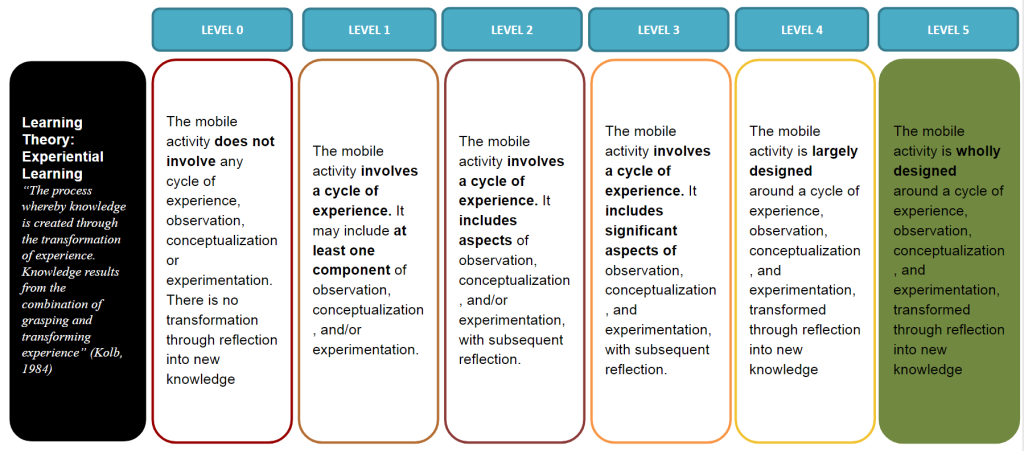
Situated Cognition
The learning was based on exploring a physical environment, providng the authentic context and activities typical of situated cognition. The project enabled learners to integrate their understanding and knowledge through a dialectic process of reflecting and acting, and to do so in a playful way (Rogers et al., 2002). The students interacted with the environment at length and with others through shared activities and language. The expert is provided in the form of the additional information accessible via the RFID tags. However, the students learn from each other on how to use and engage with these tags. The teacher’s role was largely one of support and coaching. The students learned through the exploration of the environment no longer dictated by the teacher. The data collection was used to help engage the learners in problem solving with developing and examining hypothesis on what the data would be able to tell them.
Based on this we have evaluated the case study at level 5 of the Situated Cognition rubric. “The mobile activity is wholly designed around an authentic context and activities that reflect real-life application and support collaborative knowledge construction through coaching, expert performances, process modelling and reflection” (Figure 6.2).
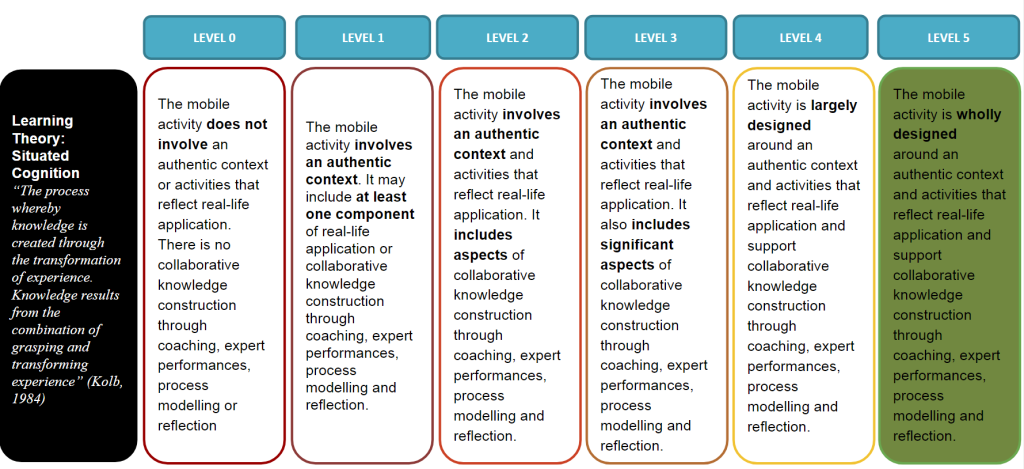
Constructivism
Underpinning this project was a rich set of located technologies which supported collaborative construction of knowledge. Learners were to work in groups to explore a real environment of the woodland. Learners were to learn from each other and collaborate with each other to gather data and learn about the environment. Mobile devices, RF identification tags, movement sensors and multi-modal displays were used to trigger and present ‘added’ digital information which students could engage with to learn about their environments (Rogers et al., 2002). This enabled the learners to be guided in their learning, however they were still able to interact and further explore by using the mobile devices to look up more information about these points of interest.
The devices were used to also take environmental readings like temperature and humidity, reflecting a typically constructivist mobile learning activity (Anand, Herrington & Agostinho, 2008). The students were engaged in active learning and used their devices to engage with high-level processing of information. The activities were wholly practical in nature and relied on the group to actively process and interpret the data and information gathered. The learning agenda was set by the students where they could choose what to explore and were encouraged to take the initiative to learn and to interact with the learning environment.
Knowledge was co-constructed by the engagement with the other learners, supplemented by the digital information provided by the instructor and by gather data via the mobile device. However, we might regard the activities as being too directed by the embedded tools to fully engage with constructivist learning and lacks the true attainment of higher-level learning and social presence, to help develop personal meaning.
Based on this we have evaluated the case study at level 4 of the Constructivism rubric. “The mobile activity is largely designed around (inter)active construction of knowledge by learners using collaboration and cooperation. Learners have control of the learning process and time and opportunity to reflect and develop personal meaning” (Figure 6.3).
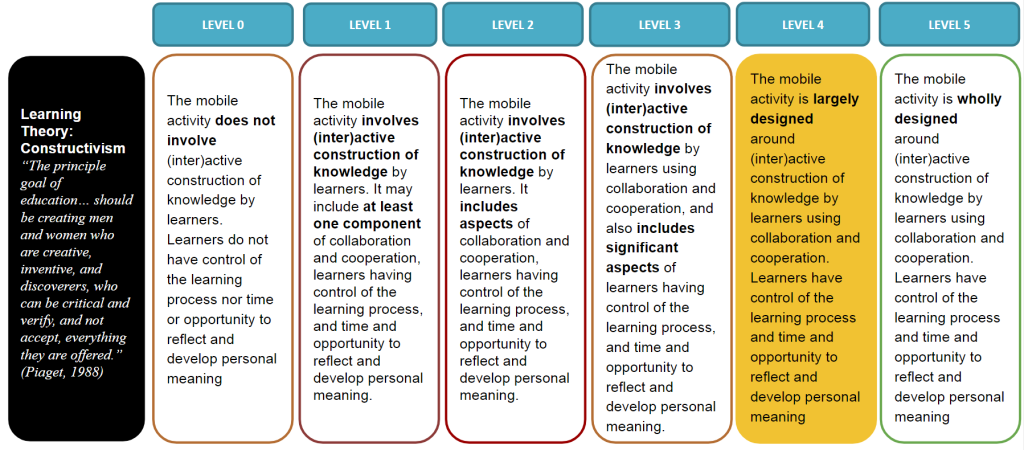
Communities of Practice
Social interaction and communities of practice were encouraged to a degree. Walkie Talkies were used by the children (novice) to communicate with a remote facilitator (expert), and used to answer questions posed by the remote facilitator. Additional information could also be received by the students via the mobile devices (Randell, Phelps & Rogers, 2003). They shared a domain and learned within it, but this community was short lived, confined to the scope of the activity. However the learning involved learners negotiating a joint enterprise with their own standards of practice and engagement, with some more taking a more peripheral participation within the learning activity.
Based on this we have evaluated the case study at level 3 of the Communities of Practice rubric. “The mobile activity involves a diverse, unifying community of practice and also includes significant aspects of shared learning accompanying a social process of information exchange and knowledge creation.” (Figure 6.4).
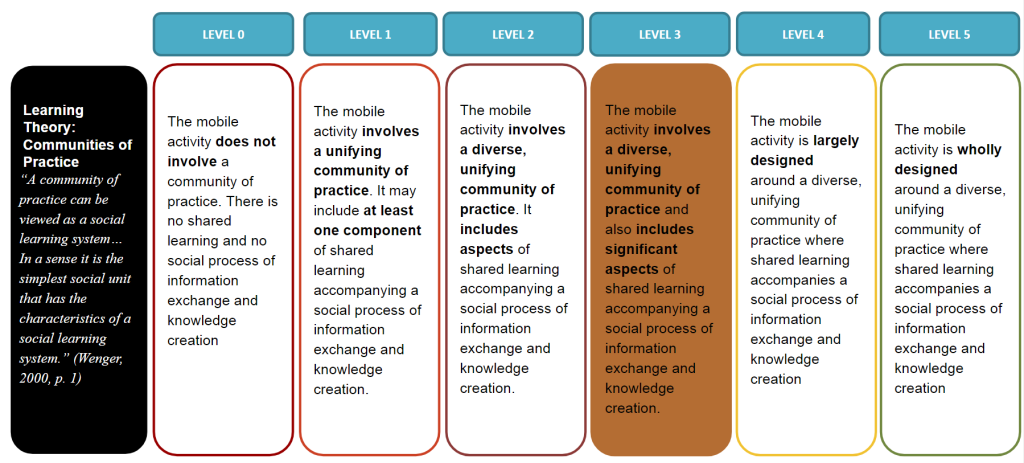
Connectivism
The connectivism component was limited by the range of networked resources and tools that were available at the time of the project, which pre-dated the publication of connectivist theory. Nevertheless, the technologically-supported environment that supported dialogue and collaboration supported some connectivist features.
Based on this we have evaluated the case study at level 2 of the Connectivism rubric. “The mobile activity involves the creation and critical evaluation of artefacts in learning networks, and includes aspects of using collaborative technologies, diverse information sources and transferable social media skills.” (Figure 6.5).
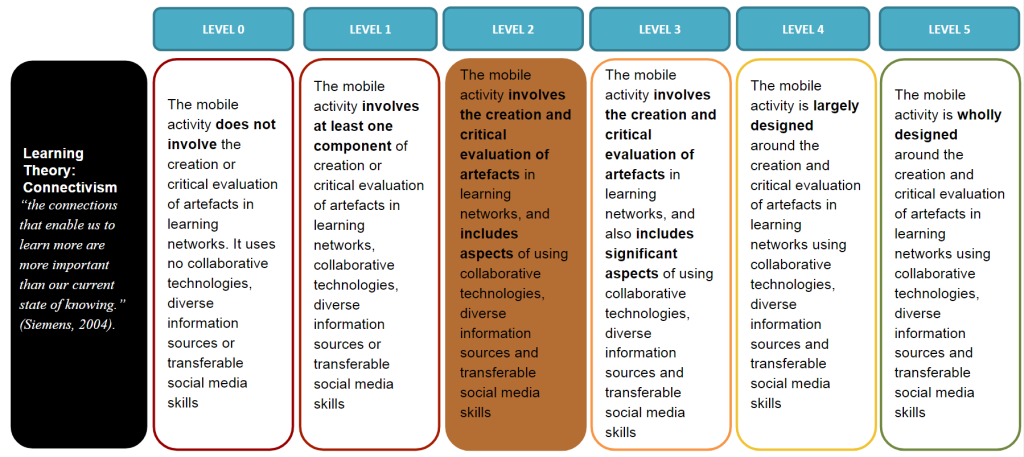
Behaviourism
Behaviourism is only conceptualised in this activity in the sense that there are some measurable learning outcomes. However, these aims are rather fluid as the experience of the activity itself is the primary focus. The activity also has some feedback with the teachers providing support and coaching as required and when sought by the students.
Based on this we have evaluated the case study at level 1 of the Behaviourism rubric. “The mobile activity involves at least one component of measurable outcomes, testing, sequenced materials, feedback or reinforcement.” (Figure 6.6).
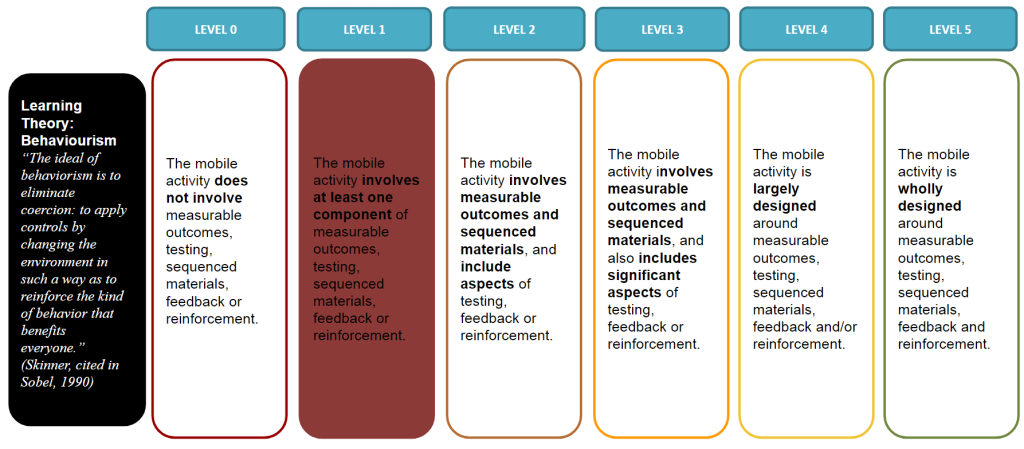
Based on this analysis it is evident that the project was underpinned, to different degrees, by the six learning theories; namely connectivism, experiential learning, constructivism, communities of practice, situated cognition and behaviourism, with a core focus on situated, experiential learning. Behaviourism was the least operationalised of the theories.
Example 2: Mobile language learning apps within a personal learning environment
Mobile Assisted Language Learning (MALL) is a popular topic for mobile learning applications and has been the subject of extensive research (Viberg & Grönlund, 2013). Reasons for the popularity of MALL include personal mobility, personalised learning, social contact and collaboration (Kukulska-Hulme & Shield, 2008). Thus any exemplar chosen to explore MALL in practice should not only provide individual language experiences but support learning with others. With this in mind we have chosen the Busuu app as one example of many, because it combines both the conventional drill and practice of a multitude of language learning apps with a connectivist approach to social media and personal learning networks (Brick, 2011). Busuu is a mobile and web self-paced language learning application. The platform allows learners to practise their skills directly with other native speakers in a world-wide community of users. The application embeds interactive multimedia content with a social networking environment (Busuu, 2017). Ketyi (2013) notes that Busuu has an active and supportive community of learning, and its social networking features scored highly in a study by Liu et al (2013), while Gaved et al (2013) emphasised the impact of its feedback and progress indicators.
Behaviourism
As with most language learning applications, Busuu is heavily underpinned by behaviourist learning principles, with the core aspect of the app focusing on drill and practice of the repetitive language activities (Storz, Maillet, Brienne, Chotel & Dang, 2012). Learners are scaffolded within their learning, where a course is broken down into learning units. Language learning units enable learners to practice and reinforce their learning, underpinned by the formation of habits mainly through imitation and repetition (Mitchell, Myles & Marsden, 2013).
Badges are used to reinforce behaviour, show achievement (e.g. completing a learning unit or finishing a course) and encourage interaction in the community (e.g. correcting posts) (Álvarez Valencia, 2014). The use of the reward system is an example of continuous reinforcement and therefore further emphasises the behaviorist approach to learning.
Based on this we can judge that this case study falls within level 5 of the Behaviourism rubric. “The mobile activity is wholly designed around measurable outcomes, testing, sequenced materials, feedback and reinforcement.” (Figure 6.7).
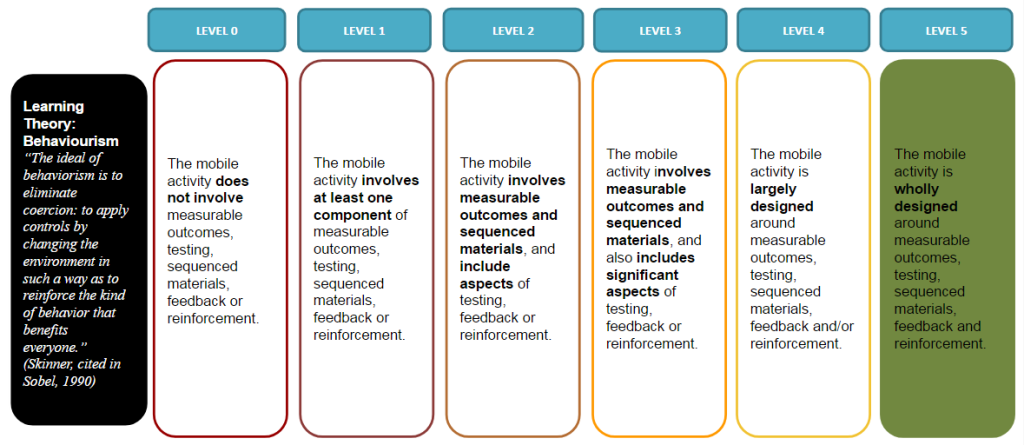
Connectivism
The use of social networks to connect with friends and others is an important focus of the app. Users sign up, send friendship invitations, and create groups to exchange text corrections, translations or simply to exchange some thoughts, as well as practice with native speakers of a specific language (Garcia, 2013). This interaction enables and supports meaningful dialogue and collaboration, a significant component of connectivist learning theory. The application provides the ability for users to network with other learners to discuss and share learning (Orsini-Jones, Brick & Pibworth, 2014). The features of the system enable a dynamic, technology-based knowledge community and learning network wherein students critically evaluate and synthesise concepts, opinions and perspectives.
Based on this we can judge that this case study falls within level 4 of the Connectivism rubric. “The mobile activity is largely designed around the creation and critical evaluation of artefacts in learning networks using collaborative technologies, diverse information sources and transferable social media skills” (Figure 6.8).
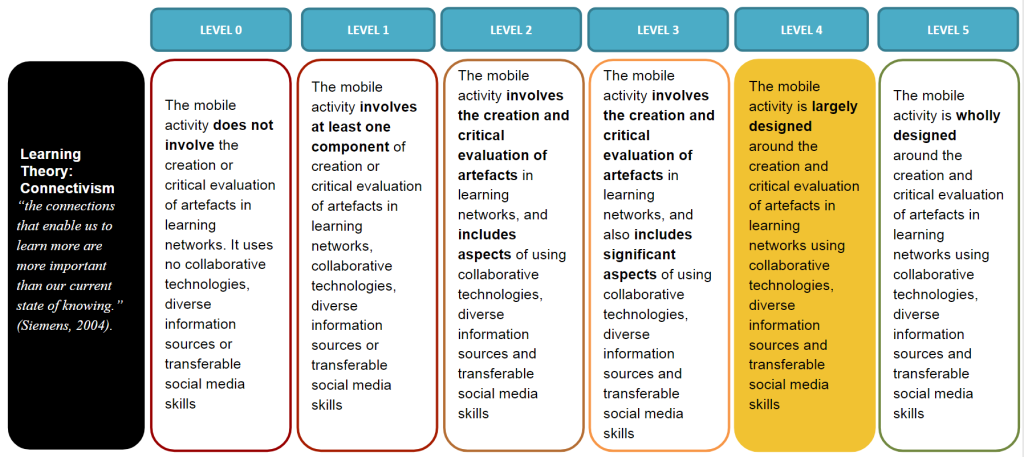
Constructivism
In addition to reinforcing and encouraging positive behaviour, badges are used to encourage collaboration and interaction between users. Some of these collaborative activities include written exercises, audio recording, and chat. These collaborative and cooperative learning activities are an important driving factor for encouraging and facilitating constructivist learning. Also underpinning the constructivist paradigm is that learning is self-paced and learners can attempt the activities at their own pace.
The badges also reinforce gameplay (Álvarez Valencia, 2014). The game play extends the behaviourist approach to also include elements of constructivism. Users are able to compare and rank themselves based on the number of Busuu-berries (the reward system used in Busuu) they have and with those of their friends. Learners are also able to challenge other users to complete learning units to obtain more berries. The gamification approach adopted in the application helps to “builds goal-orientation, collaboration, and competition into otherwise boring or hard activities” (Reinhardt & Chen, 2013 p 13). This approach helps make the learning more active and supports the transformation of the learning into a meaningful process.
Based on this we can assume that this case study falls within level 3 of the Constructivism rubric. “The mobile activity involves (inter)active construction of knowledge by learners using collaboration and cooperation, and also includes significant aspects of learners having control of the learning process, and time and opportunity to reflect and develop personal meaning.” (Figure 6.9).
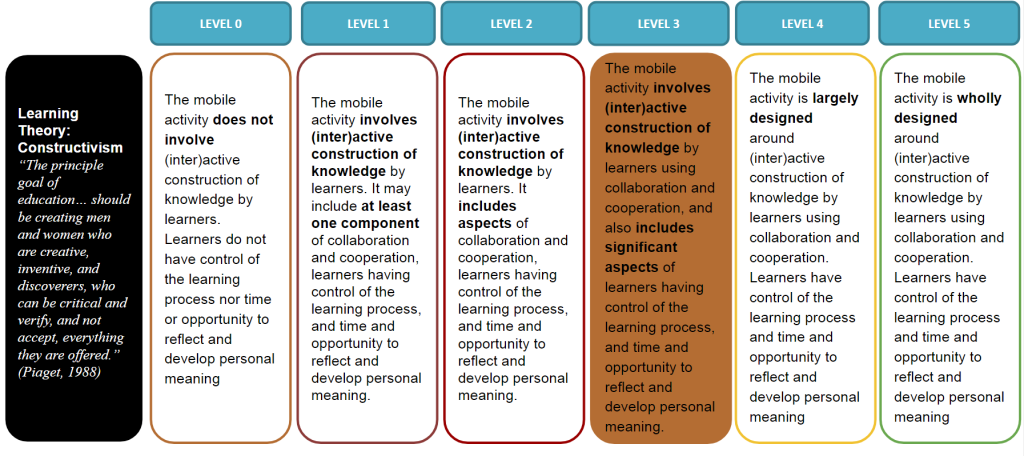
Communities of Practice
Another factor within the application is its strong domain-based learning community which is an important component of communities of practice (Wenger, 2000). Users are encouraged to engage with other learners, for example by peer-reviewing others’ audio-recordings of dialogues. The audio recording facility allows learners to participate in a dialogue with others and more advanced learners are encouraged to support new learners so learners are encouraged to be both teacher and student. The social network allows people to correct other users’ written work, making each user an expert in their own language (Garcia, 2013).
Based on this we can judge that this case study falls within level 3 of the Communities of Practice rubric. “The mobile activity involves a diverse, unifying community of practice and also includes significant aspects of shared learning accompanying a social process of information exchange and knowledge creation.” (Figure 6.10).
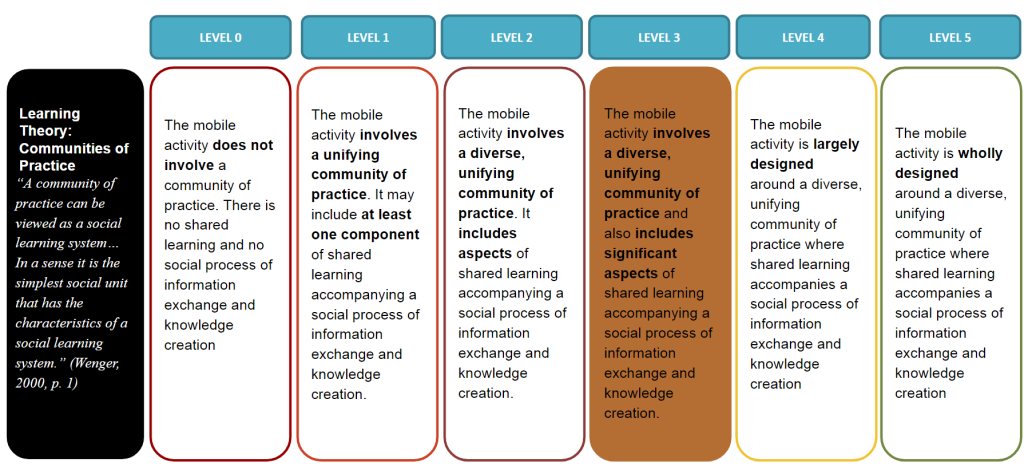
Situated Cognition
Busuu is used not used to help support a learner while engaging with their environment, however there is still a strong real-life application where learners are able to interact with native speakers to practice and develop their skills. Therefore, based on this, we can judge that this case study falls only within level 1 of the Situated Cognition rubric. “The mobile activity involves an authentic context. It may include at least one component of real-life application or collaborative knowledge construction through coaching, expert performances, process modelling and reflection.” (Figure 6.11).
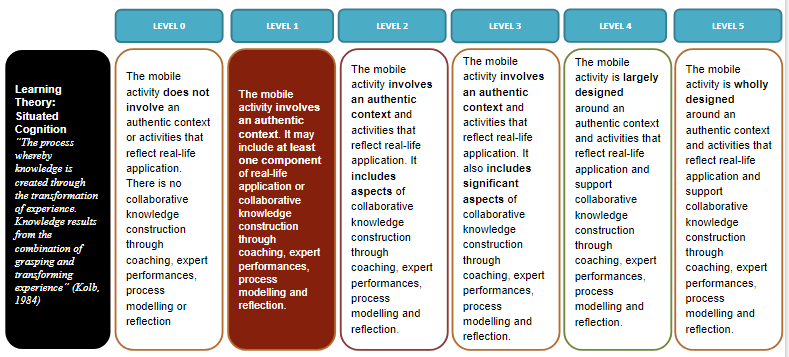
Experiential Learning
The mobile activity shows no evidence of any cycle of experience, observation, conceptualization or experimentation. There is simply not enough structure to the activities within Busuu to ensure that learners go through a reflective cycle of experience. They may do so, but only through their own agency. As a result, there is no transformation through reflection into new knowledge as a direct result of using the app. Again, this may well happen through learner agency but is not embedded into the application design. Therefore, based on this, we can judge that this case study has no evidence of experiential learning as is assessed at level 0 of the Experiential Learning rubric. “The mobile activity does not involve any cycle of experience, observation, conceptualization or experimentation. There is no transformation through reflection into new knowledge.” (Figure 6.12).
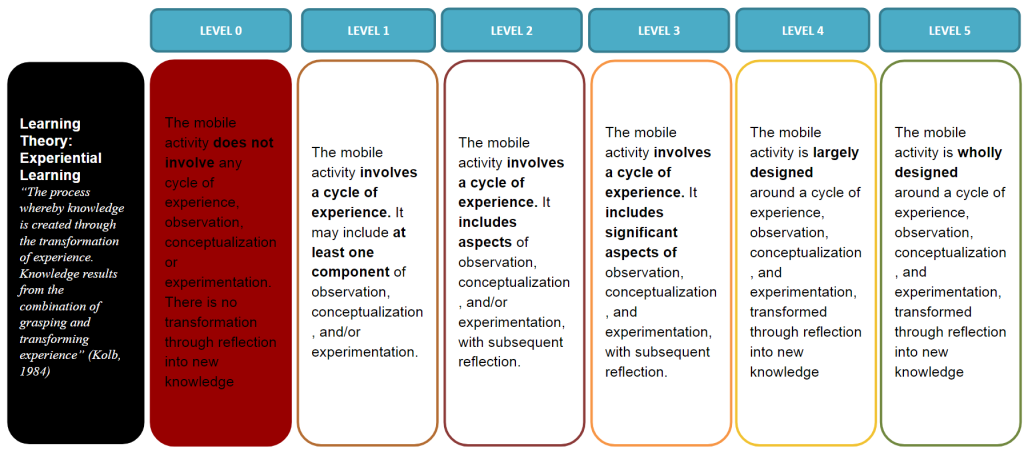
Our analysis suggests that the application mainly leverages the principles of four learning theories; behaviourism, constructivism, connectivism and communities of practice, but is most strongly behaviorist and connectivist. Situated learning is only marginally linked with this activity and there is no evidence of experiential learning intrinsic to the activity.
The Analyser Tool
The Mobile Learning Activity Design Analyser is a web based tool that provides an interactive feedback mechanism for mobile learning activity design. Unlike the rubrics, it does not focus on individual learning theories. Rather it takes various features from the six theories and proves a series of statements about these. The user can select the level of presence of each of these statements in a particular design. The tool uses these responses to analyse the theoretical content of the design and gives feedback as to how it might be improved. The tool can be used multiple times to help refine an activity design.
It should be noted that the tool we have developed was influenced by the approach of the Mobile Learning Toolkit for Educators (Burden and Kearney, 2017) based on the iPAC framework. However, the basis of their approach is the three principal constructs of personalisation, authenticity and collaboration, while ours focuses more on specific aspects of a broader set of learning theories. Further, the output from the Mobile Learning Toolkit for Educators is a polar chart, but no specific recommendations for further development are provided. Thus we see our work as significantly different in focus.
See the Digital Extras section for a short video that provides an overview of how the Digital Analyzer works and can be used to evaluate a mobile learning activity.
Initial design
In this mobile learning activity, individual learners will be guided by a mobile learning app to several outdoor locations using the GPS sensors on their mobile devices. At each location they will be asked by the mobile learning app to answer a multiple choice question about that particular destination. For this example we assume that these destinations are local sites of historical interest, so a multiple choice question might ask something like ‘in what year was this foundation stone laid?’ At the end of the activity each learner will receive their overall score and feedback of the correct answers.
Analysing the Design
If we apply the mobile learning analyser to this design, we might assess it at the levels shown in the following example. We will show each step in the 6 step analysis process and indicate our responses to each of the statements (note that there is a degree of subjective judgement in the process, so you might think differently). Each step comprise four statements, and the current design is evaluated against each statement using a 5 point slider that ranges from 0 (not at all) to 4 (this is the primary content).
The first four statements are as follows (Figure 6.13). We have assessed the design as being relatively high in terms of measurable and observable outcomes, and testing whether those outcomes have been achieved. However, there is less facility for feedback allowing learners to take corrective action or positive reinforcement, since feedback occurs at the end.

Looking at the next four statements (Figure 6.14), although the activity is sequenced there is no meaningful process in that sequence, simply a series of questions at the same kind of level. Learners have no control of the learning process, and while there may be some opportunities for reflection and construction of their own learning these are very limited within the constraints of the activity.

The activity design performs particularly poorly against the next four questions (Figure 6.15) since it is an individual activity and there is no collaboration, either directly with others or through collaborative Technologies. There are some small elements of experience and observation but no defined cycle, and there is no opportunity for conceptualisation or experimentation.
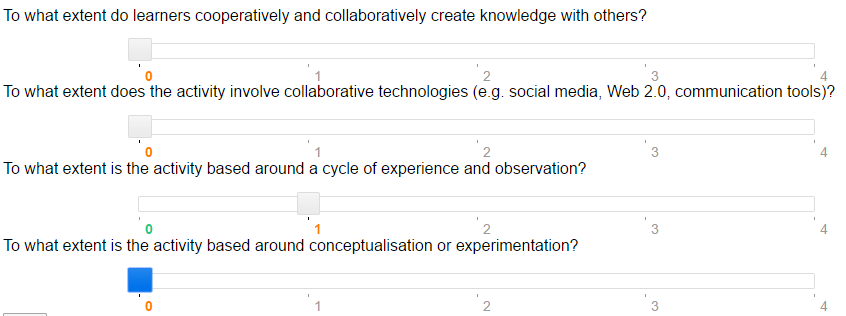
For the next four questions (Figure 6.16) the learning activity certainly does involve an authentic context, and there is at least the potential for a degree of real life application, depending on the particular context. However there is no coaching, expert performance or modelling evident in the design.
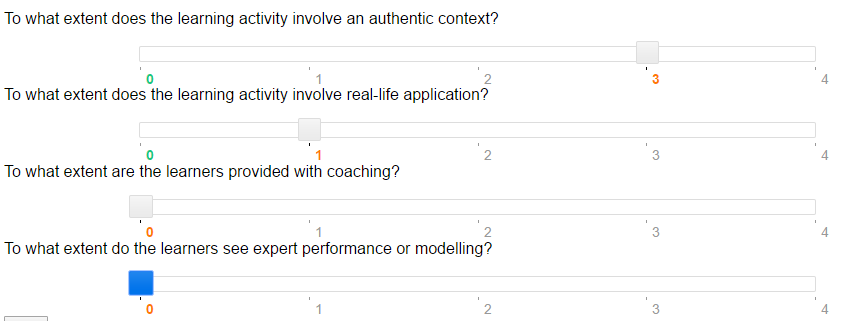
The design also performs poorly against the next set of questions (Figure 6.17), since there is no social community or shared learning involved in the process.
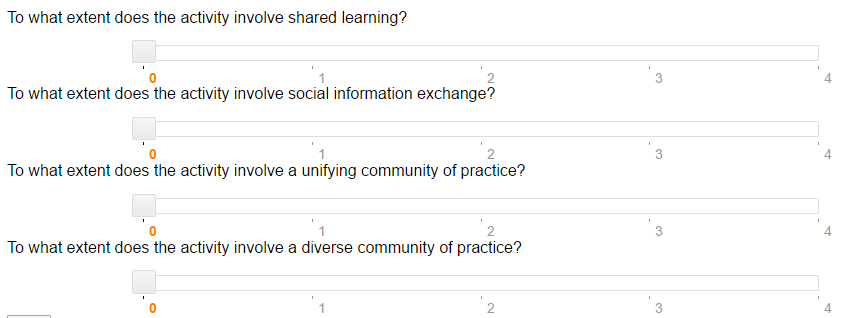
In the final set of questions (Figure 6.18) the application again performs rather poorly. There are no social media skills or created artefacts. It is possible that the information sources in the activity could be somewhat diverse, but this would depend on the choice of locations.
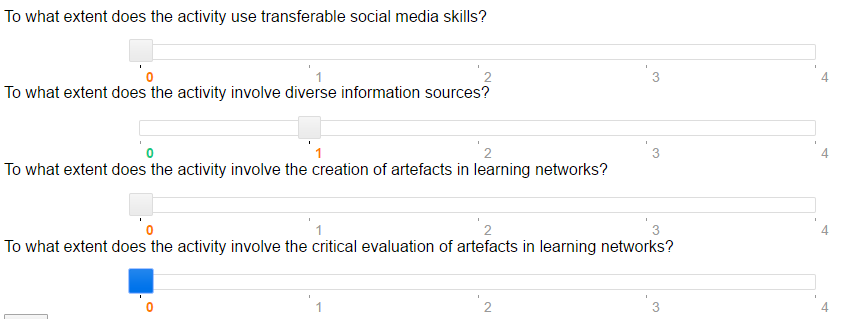
The chart (Figure 6.19) generated by the tool suggests that the overall degree of learning theory in the proposed design is rather limited, so there may be some opportunities to rethink the design to provide a more effective learning experience.
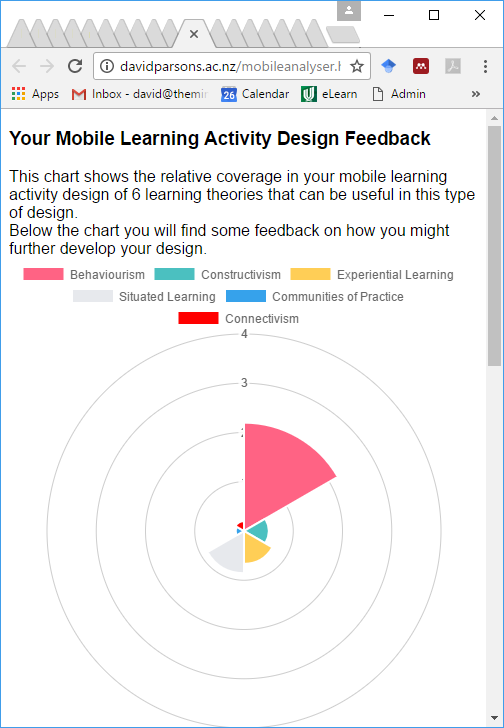
The feedback provided by the analysis tool is shown below (Figure 6.20).
| The scores for each learning theory are as follows:
Communities of Practice with a score of 0.17 Connectivism with a score of 0.20 Constructivism with a score of 0.50 Experiential Learning with a score of 0.67 Situated Learning with a score of 0.86 Behaviourism with a score of 2.20
The theory best covered in your design is behaviourism with a score of 2.20
The theory least covered in your design is Communities of Practice with a score of 0.17 You might consider including further aspects of Behaviourism in your design; ● Including measurable outcomes that learners can observe and measure their progress against ● Testing whether learning outcomes have been achieved ● Sequencing materials (e.g from simple to complex, known to unknown, knowledge to application) ● Giving feedback to learners on their progress so they can take corrective action where required ● Providing positive reinforcement of learning.
You might consider including further aspects of Communities Of Practice in your design; ● Providing activities that involve shared learning ● Providing activities that involve social information exchange ● Involving learners in a unifying community of practice ● Involving learners in a diverse community of practice ● Enabling learners to actively construct their own knowledge ● Enabling learners to cooperatively and collaboratively create knowledge with others |
Figure 6.20: Final screen showing the scores for each learning theory and how they could be improved.
Redesigning the Activity
As seen in Figure 6.20, the tool provides the user with some advice as to how the design could be improved. This focuses on two areas; where is the activity strongest in terms of learning theory, therefore what is already reasonably well established and could be further developed? Also, what area is least covered? Perhaps considering this might bring a new and interesting dimension to the activity design. In this case behaviourism was the theory with the best coverage and communities of practice the least, so with this in mind let us consider redesigning the activity by taking on board some of the advice.
Looking at the suggestions made, it would be helpful if we were to incorporate a better sequence of materials, integrating ongoing feedback that would enable users to take corrective action and also to receive positive reinforcement of learning. One way of doing this might be to ensure that the sequence of locations that the user is taken through creates a kind of narrative that will build, perhaps, a social, fictional, historical, economic or political story. Feedback on multiple choice questions should be immediate and there should be positive reinforcement such as gamification components (badges, leaderboards etc.) Also, the sequence of learning should progress, so we might start with simple multiple choice questions, move to more discursive questions, or provide greater challenges such as giving clues to something that should be photographed and described.
To include components of a community of practice, learners need to be engaged with other learners. This need not be in a physical context but could be sharing discoveries in an online community so, for example, if learners are attempting to answer clues to find and describe locations their photographs and descriptions could be shared on social media to enable learners to actively construct knowledge and do so collaboratively with others. The activity should enable new locations, journeys, narratives and challenges to be co-created by the learners.
These are just a few suggestions about how the advice from the analyser tool might be used to develop and enhance an initial mobile design, and of course the tool could be used multiple times until the activity designer is satisfied with their design.
Conclusion
Mobile learning is no different from any other type of technology supported learning, where careful foregrounding of appropriate learning theories over choice of tools is important to ensure that effective learning is likely to occur. It is, clear that there are a number of current theories and approaches that are strongly aligned to the unique affordances of mobile technology (see for example Ozan & Kesim (2013) and Herrington & Herrington (2007)). This e-chapter covers how current mobile learning theory can be mapped to aspects of task design. The tools covered in this chapter each explain how these tools can be used to develop a toolkit to guide educators in designing effective mobile learning activities. The resources enable a detailed explanation of how this toolkit can be used by educators, as either an analytical or a design tool, explained through examples of different mobile learning activities.
